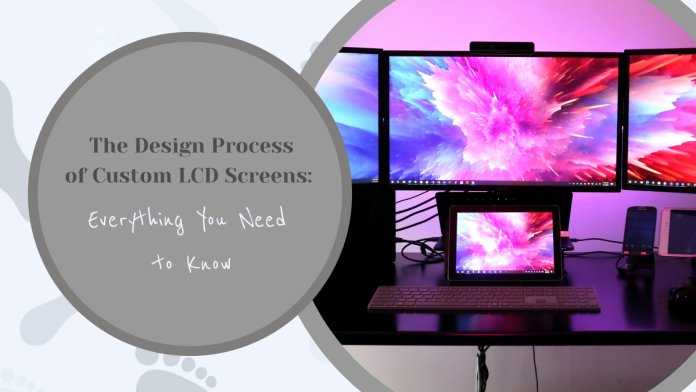Nowadays, most of the technology we use on a daily basis is a standard model that we can easily pick up at any electronic goods store when we need a new one. With our hectic life pace, we tend to settle for the quickest solution and opt for the gadgets that are ready and waiting for us on the shelves of our local stores. Sometimes, the standard models work perfectly well and serve their purpose. However, it can happen that our needs go far beyond what’s currently available and in stock. Then, we need to turn to other solutions that involve a bit of planning and patience on our side.
When talking about buying standard-sized LCD screens, the process we know is usually pretty simple and straightforward. You research models online, compare prices and then either proceed with ordering online or you go to the store and walk out with a fancy new model.But what happens when the standard dimension screen doesn’t pair well with your devices?
That’s when you start thinking about customized solutions. Luckily, you can always turn to a custom LCD manufacturer for help.
Custom LCD screens provide tailored solutions that easily integrate into specific applications across different industries. These specialized displays are carefully designed to fit specific requirements, offering a level of precision that standard alternatives can’t match.
As key components in devices like medical equipment and industrial machinery, custom LCDs play a very important role in shaping modern technology. In this short yet detailed post, we’ll dive into the complex design process of custom LCD screens and uncover the key considerations and steps involved.

What are custom LCDs?
LCDs act as screens displaying visual information in various electronic devices. Custom LCDs, however, take this technology a step further by offering solutions tailored to the exact specifications of the user. The ability to customize their size, shape, resolution, and other parameters makes custom LCDs indispensable in scenarios where off-the-shelf alternatives fall short.
The intricate design process of custom LCD screens
What does custom LCD manufacturing involve? Although you might think there’s no need for you to know the details, it’s much better to have a fundamental understanding of what goes into the process as that will make choosing a custom LCD manufacturer much easier.
Define Application Requirements
The first step is thinking about what kind of custom screen you need. Think about the specific dimensions and the purpose of the screen. The process of designing custom LCD screens begins with a definition of the application’s requirements. This step involves understanding the unique demands placed on the display. You also need to consider environmental conditions, required viewing angles, resolution specifications, and any specific functionalities crucial to the application.
Outlining your requirements is the most important thing to do at the beginning as that’s when you set the tone for the rest of the process.
Making the prototype
Then, we can move on to the next stage. With application requirements outlined, the next phase involves translating them into designs through brainstorming and making first prototypes. This process allows for the visualization of the custom LCD’s physical attributes and performance characteristics. Prototypes serve as real-life representations, enabling hands-on evaluation and testing. Feedback from these prototypes is crucial as it helps improve the final result.
The dynamic nature of this phase highlights the importance of flexibility and adaptability in responding to evolving design considerations.
Communicating with the manufacturer
Effective communication with the manufacturer is necessary for a smooth custom LCD design process. Communicating specifications clearly and precisely is a must. This includes conveying requirements related to display size, resolution, color depth, and the type of backlight technology.
Additionally, you should mention anything else you view as important. It helps the manufacturer get a good idea on the type of custom LCD you need. The process involves a lot of cooperation and that’s why you need to be transparent.
Choosing the materials
The selection of materials is necessary for determining the performance and durability of custom LCDs. That means choosing the type of glass, polarizers, and backlight technology. Have in mind that your choices directly impact factors such as display clarity, robustness, and power efficiency. The design process involves careful consideration of these materials and weighing their pros and cons in the context of the application’s requirements.
Touchscreen features
In cases where touch functionality is required for the application, you need to make sure you mention that to your manufacturer very early on. Then you’ll also need to decide on the type of the touchscreen you want. If you’re not familiar, you can do a quick research online, or simply ask your manufacturer.
Ongoing support
It’s important to highlight that the process doesn’t end once you have your end product. If all goes well, you’ll probably want to continue your collaboration with the manufacturer and you’ll go through the same process for other displays as well. Also, if you’ve chosen a good manufacturer, they won’t leave you stranded. Instead, they’ll be available to support you and provide further guidance.

The final word
Hopefully, we’ve managed to simplify the design process to you and you should now be more aware of what it includes. As a user, you need to communicate your needs clearly and let the manufacturer know what you’re looking for. It’s as easy as that. The complexities of the design process are then in the hands of their team.
Custom LCDs are a great way to give your devices a personal signature and although they do require some patience and time, the efforts are completely worth it.
